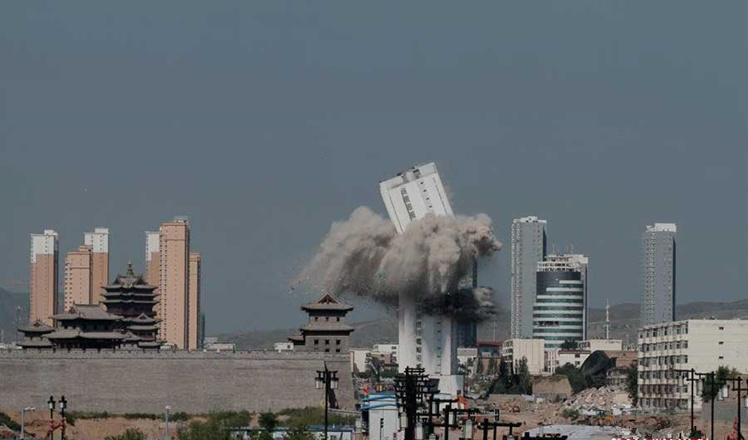New satellite keeps eye on sea interests
Updated: 2016-08-11 08:07
By Zhao Lei(China Daily USA)
|
||||||||
High-tech radar will also improve nation's ability to forecast, warn of natural disasters, experts say
China is putting its nearby waters under more effective surveillance with its newly operational high-tech satellite.
Launched on Wednesday morning, the Gaofen 3 high-resolution Earth observation satellite will help the nation beef up its capabilities to safeguard its maritime interests and to help forecast and warn of natural disasters, space program officials said.
The satellite was delivered by a Long March 4C rocket that blasted off from the Taiyuan Satellite Launch Center in Shanxi province.
It is equipped with a radar system that captures images from space with a resolution down to 1 meter, according to the State Administration of Science, Technology and Industry for National Defense, which oversees China's space programs.
The Gaofen 3, which was developed by the China Academy of Space Technology in Beijing, is capable of generating radar images in all weather conditions and can work around the clock.
The satellite will play an important role in monitoring the marine environment, islands and reefs, and ships and oil rigs, said Xu Fuxiang, head of the Gaofen 3 project at the academy.
He said that considering China has a total of 32,000 km of coastline, 380,000 square kilometers of territorial seas and more than 6,500 islands that have an area of at least 500 squaremeters, satellites like the Gaofen 3 will be very useful in safeguarding the country's maritime rights and interests.
The Gaofen 3 will also help in disaster forecasting, assessment and relief, which now heavily rely on imported satellite data, Xu added.
Gaofen 3 has a designed service life of eight years, said Liu Jie, Gaofen 3's chief designer at the China Academy of Space Technology. He added that the satellite is the best of its kind in the world in terms of technological level and imaging mode.
With 12 imaging modes, the satellite is able to take wide pictures of Earth and to photograph specific areas in detail, Liu said.
China launched the Gaofen project in May 2010 and has listed it as one of 16 key national science and technology projects. The aim of the Gaofen project is to form a space-based, high-resolution Earth observation network.
Gaofen 1 was sent into space from the Jiuquan Satellite Launch Center in April 2013. Four other Gaofen satellites were launched in 2014 and last year.
The Gaofen 5, 6 and 7 will be optical remote sensing satellites and are under development, according to the State Administration of Science, Technology and Industry for National Defense.
Currently, 26 provincial-level regions have set up Gaofen data application centers to receive and distribute images and data generated by Gaofen satellites, the administration said.
zhaolei@chinadaily.com.cn
(China Daily USA 08/11/2016 page1)
- Nepal's newly elected PM takes oath
- Texas gun law worries incoming students
- China vows to deepen economic, trade cooperation with ASEAN
- Fire guts Emirates jet after hard landing; 1 firefighter dies
- Egypt's Nobel-laureate scientist dies of illness in US
- THAAD muscle flexing unmasks anxiety over declining hegemony

 Breathtaking wedding ceremony in the air
Breathtaking wedding ceremony in the air
 Beijing's museum brings spirit of craftsmen alive
Beijing's museum brings spirit of craftsmen alive
 Phelps adds Olympic gold medal haul to historic 21
Phelps adds Olympic gold medal haul to historic 21
 Weightlifter Deng Wei breaks world records
Weightlifter Deng Wei breaks world records
 Top swimmer Sun Yang makes sweet revenge
Top swimmer Sun Yang makes sweet revenge
 Lin Yue and Chen Aisen win Olympic gold medal
Lin Yue and Chen Aisen win Olympic gold medal
 Artist creates mini-mes for loving couples at Qixi festival
Artist creates mini-mes for loving couples at Qixi festival
 Skyscraper demolished outside ancient city
Skyscraper demolished outside ancient city
Most Viewed
Editor's Picks

|

|

|

|

|

|
Today's Top News
Phelps puts spotlight on cupping
US launches airstrikes against IS targets in Libya's Sirte
Ministry slams US-Korean THAAD deployment
Two police officers shot at protest in Dallas
Abe's blame game reveals his policies failing to get results
Ending wildlife trafficking must be policy priority in Asia
Effects of supply-side reform take time to be seen
Chinese State Councilor Yang Jiechi to meet Kerry
US Weekly

|

|